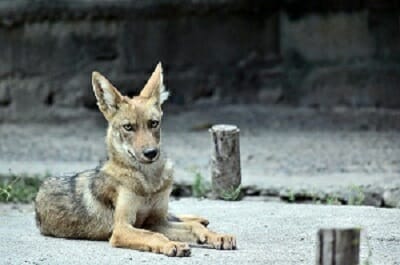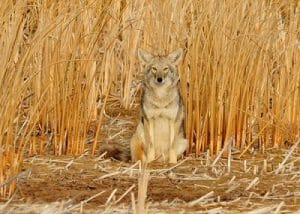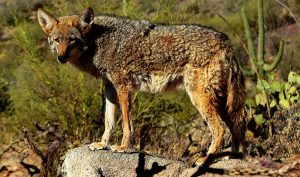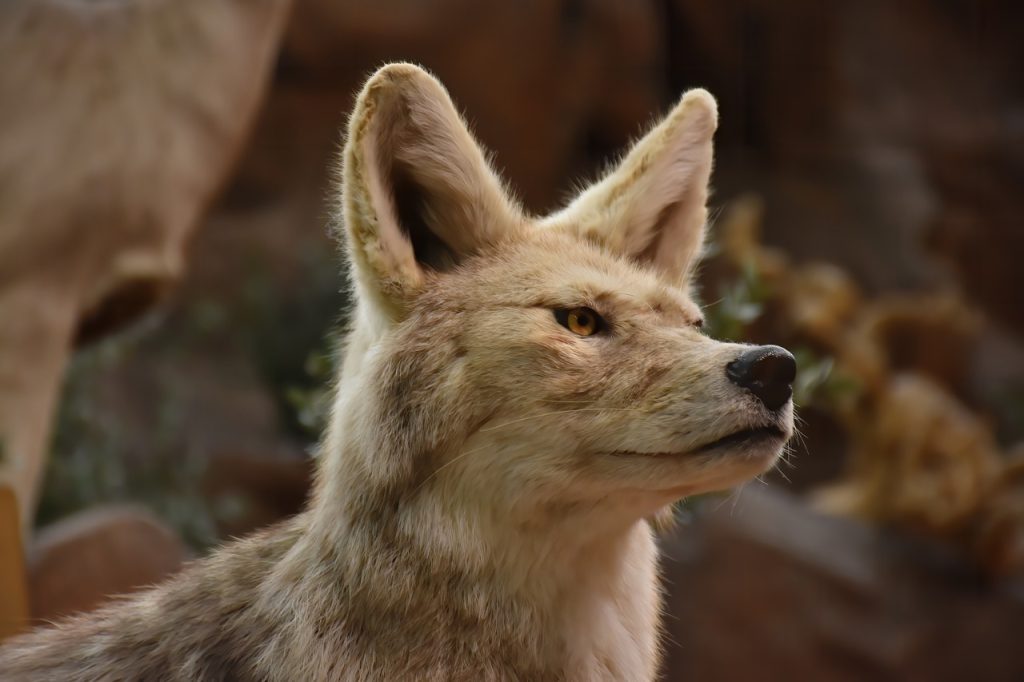
Much like we have our own languages in the human race, animals all have their own ‘languages’ and ways of communicating with one another. As you may expect, coyotes are very much the same in this respect.
Being able to warn their puppies of any dangers coming their way is incredibly important. Coyotes make a range of different sounds that represent different emotions and warnings.
It’s vital to both understand at what times to hunt a coyote by having the skills to comprehend how they’re communicating with each other. With this knowledge you’re much more likely to succeed in your endeavors as a coyote hunter.
Coyotes are FAST, being able to run more than 35 miles per hour. They also group together in packs during the winter months and during the spring as it’s easier for them to hunt during these months.
Coyotes will hunt domestic animals and wild animals alike, but they don’t really hunt for humans. If you make some sounds to scare them off, you should be able to get them to flee.
When hunting coyotes, you should make sure that you’re armed with an appropriate light and a rifle.
Don’t use inhumane methods, there’s no use in making an animal suffer before death when you can make it fairly painless for a peaceful death. All you need is to kill it once.
When a coyote is trying to communicate with its puppies, it will usually make a woofing sound to tell them that any danger is near so they know they need to hide.
Many people view hunting as a hobby instead of as a thing you can do professionally considering it’s not something that requires a formal education.
With that being said a lot of hunters will actually help farmers out with providing a service to exterminate any coyotes invading their land and preying on their livestock.
Coyotes will prey on the vast majority of animals, even domestic animals. If you know how they communicate with other members of their species it becomes a lot easier to understand how to properly find and hunt the predator.
Coyote Howling
 Coyotes will howl to make other coyotes aware of their location. This is the most common way that most hunters find them.
Coyotes will howl to make other coyotes aware of their location. This is the most common way that most hunters find them.
A lot of hunters will often even hunt during the night time as they think that hunting at night will make it easier to find coyotes as they interact with each other more during the night.
The mating time for a coyote is at the beginning of the year, and this is a good time to draw them out of where they are hiding.
If coyotes hear a howling sound they will immediately believe that another coyote is coming in to invade their territory so it will come out and investigate the potential intruder.
Coyote Puppy Calls
Of course, we as humans will answer any sounds of distress from our babies. The same is true of coyotes. Whenever a pupp calls the coyotes nearby will flock to come and save the puppy from any potential harm.
On occasion the coyote does not come and rescue its pup immediately, but with some tenacious puppy calling the coyote will eventually come out and investigate the distress sounds.
You should be careful with this kind of call, as some coyotes will respond to puppy calls anticipating getting a meal out of it. If you don’t want to be their next meal, it’s advised that you take extra caution.
The most successful way to get a response from the coyotes with this call is to continually make the sound. This will pique the coyote’s interest and they will come to the area from where the sound originates.
Essentially it’s like calling out to the coyote and persuading it to come to your location, however without enough emphasis the coyote will lose interest and leave.
Coyote Barking
The barking sound is used to stop a coyote from dashing away while you try to take the shot. Coyotes will stop to listen to a barking sound as they will be curious where the sound has originated from.
Make sure that you don’t sound like a male coyote when barking as this can send younger coyotes scurrying away in fear.
There are a couple of tricks worth keeping in mind when hunters are operating in Coyote territory. You should always make sure that you’re aware of where the coyotes are so you don’t fail in what you’re doing.
Make sure that you’re calm and still while you start going near to the coyote pack so you don’t end up scaring them. You should also ensure that you’re camouflaged with the environment around you.
Coyotes are also able to sniff out a human scent from quite far away so you should try to ensure that you’re positioned against the wind direction.
Make sure that you use the correct sound to get the coyote to come to you. Distressed puppy or prey sounds will make the prey run to the rescue or to slaughter the prey before it escapes.
If a coyote spots you before you call them, the coyote will not emerge from their hiding place as you’ve already given them ample warning that a threat to their safety is in the vicinity.
This is why it’s essential to ensure that you are properly hidden and that you are positioned somewhere that you can clearly see a coyote coming your way when you call them.
Make sure that your presence isn’t clear by doing things like loudly slamming the door of your truck. A sound like this will make the coyote run for miles in the opposite direction.
Try to be as quiet as you possibly can when trying to find the ideal location to position yourself.
When feeding on livestock, coyotes can be quite destructive, but alternatively they’re also helpful in the sense that they help to control any pests on the farm that will cause diseases in any domestic or wild animals.
If you’re thinking about hunting a coyote, or any other predator for that matter, you should always be mindful of the contribution they’re making and not kill them.
When you’re trying to hunt coyotes, there are mp3 callers out there that can be used during the process to create the kind of sounds a coyote would make while communicating.
This can make it a whole lot easier for the hunter to lure their prey as they won’t need to eventually get tired of making the sound as it’s not manual.
The coyote is incredibly clever. It can use its sense of smell to detect a human presence.
If they hear you approaching they can take off in a mere second so this can make it a little harder to hunt them down. It requires an awful lot of patience to hunt them down.
It can be a little difficult to hunt coyotes sometimes, and it’s quite dissimilar to hunting deer. Hunting coyotes requires a lot of skill and knowledge of the kinds of sounds that will attract the coyote towards your location to make your hunting endeavor a lot easier.
You can use this information to make hunting coyotes a lot easier. As we said earlier though, it’s still advisable to consider what the predators can help with before killing them as they could come in handy with keeping pests away.
 Most hunters with a lot of experience will already know the information we’ve said above, but if you’re new you may not be clued up on what it takes to lure in coyotes for a successful hunt.
Most hunters with a lot of experience will already know the information we’ve said above, but if you’re new you may not be clued up on what it takes to lure in coyotes for a successful hunt.
Reading the calls above can give you a lot of advantage in understanding what you need to look out for when you’re calling coyotes. It will also help you to keep yourself safe by making the appropriate sounds to scare them away from you too!
If you’re looking to make your life easier by not manually creating your coyote calls, why not invest in buying an electronic coyote call? These can make your life a lot easier and they can also be used for hunting down other predators too, so it’s worth it to look into it.
The Sounds That Coyotes Make
Coyotes are cunning and versatile animals that inhabit a variety of habitats across North America. They are intelligent creatures with a wide-ranging vocal repertoire, and their vocalizations have been studied extensively by scientists, researchers, and enthusiasts alike. As a result, recognizing and understanding the different sounds that a coyote makes is crucial for anyone who lives in an area where they are present. In this blog post, we will explore the various sounds that a coyote makes, including their howls, barks, yips, growls, and whines. We will examine the different contexts in which they use these sounds, whether it be for territorial or social communication or in response to environmental stimuli. We will also discuss how to differentiate between the vocalizations of a coyote and those of other similar-sounding animals like dogs and wolves. By the end of this post, you will have a deeper appreciation for the fascinating world of coyote vocalizations and will be better equipped to identify and respond to their

1. Coyotes are known for their distinct vocalizations, which include howls, barks, yips, and whines.
Coyotes are known for their distinct vocalizations, which vary widely and include a range of sounds such as howls, barks, yips, and whines. These sounds are collectively referred to as coyote calls, and they play a vital role in coyote communication. Coyote howling, for instance, is one of the most recognizable and well-known sounds that a coyote makes. It is typically heard in the evening or at night, and can be used to communicate with other members of the pack, establish territory, or signal a kill. Despite their reputation for being solitary animals, coyotes are actually quite social and use a wide range of vocalizations to interact with each other and other animals in their environment. Studying these sounds and understanding their meanings can provide valuable insights into coyote behavior and ecology.
2. Howls are the most well-known sound coyotes make, often used to communicate with other members of their pack or to establish territory.
Coyotes are known for making a variety of sounds in their communication with each other. However, the most iconic sound associated with these wild canines is their howling. Coyotes are known to produce this howling sound for various reasons, most commonly to communicate with members of their pack. Howls are also used as a territorial signal to nearby packs and can travel up to three miles away in open terrain. Coyotes can also produce a range of other calls such as yipping, barking, and whining, each with its distinct meaning. These calls help establish their social hierarchies, attract potential mates and ward off predators. As part of their vocal repertoire, Coyote howling and other calls are important tools for the species that increase their chances of survival in the wild.

3. Barks are short, sharp sounds that are used to alert other coyotes of potential threats or to signal the end of a hunt.
Barks are one of the most commonly heard coyote vocalizations, and they serve as a means of communication between members of the pack. These short, sharp sounds can be used for a variety of purposes, including alerting others of potential threats, signaling the end of a hunt, or as a way to convey territorial boundaries. Barks are typically brief and can often be heard in rapid succession, making them easily recognizable to those familiar with coyote calls. They are an important part of coyote communication and can provide valuable insight into the social dynamics of these elusive animals. When combined with other coyote vocalizations such as howling, yipping, and growling, barks help to create a rich and complex language that helps these creatures to navigate their environments and communicate effectively within their packs.
4. Yips are high-pitched sounds that coyotes make when they are excited or agitated, often heard during play or after a successful hunt.
Coyotes are highly vocal animals that communicate with each other through a variety of sounds, including yips, howls, and calls. Yips are high-pitched sounds that coyotes make when they are excited or agitated, often heard during play or after a successful hunt. These yips can also serve as an alarm call to alert other members of the pack to danger or to signal the location of prey. Coyote howling is perhaps the most iconic sound associated with this species, and is used for a variety of purposes such as territorial marking, social bonding, and communication between individuals. Coyote calls are also used to establish hierarchy within a pack, with dominant individuals typically having a deeper, more resonant call. Understanding the different sounds that a coyote makes can provide valuable insights into their behavior and social dynamics, as well as helping to identify their presence and location in the surrounding environment.
5. Whines are softer, more drawn-out sounds that coyotes make when they are in distress or seeking attention from their pack.
Coyotes are known to have a complex communication system, and whining is one of the sounds that coyotes produce. Whines are softer and more drawn-out sounds that coyotes make when they are in distress or seeking attention from their pack. They may sound like one long, high-pitched note or a series of notes that rise and fall in pitch. Coyotes use whines as a type of vocalization to express their current emotional state or physical condition, such as when they are hungry or injured. Whining is a form of vocalization that may also serve as a way of signaling to potential predators or other coyotes in the area. Understanding the different coyote calls and howling patterns can help people differentially identify the vocalizations they hear in the wild.
6. Coyotes also make a variety of other sounds, including growls, snarls, and huffs, which are used to communicate warnings or aggression.
Coyotes are known to be vocal animals, and their unique sounds are a key aspect of their communication. While most people are familiar with their well-known howls, coyotes also produce a wide range of other sounds that serve different purposes. Growls, snarls, and huffs are often used to communicate aggression or warnings to other members of the pack or intruders. These sounds can be alarming and intimidating to humans, making it important to stay alert while in areas where coyotes are present. Understanding the different types of coyote calls and their meanings can be helpful in identifying potential threats and taking appropriate actions to protect yourself and your pets.

7. The pitch, duration, and frequency of coyote vocalizations can vary depending on the context in which they
Coyote howling and calls are some of the most recognizable sounds in the animal kingdom. These vocalizations can serve a variety of purposes, depending on the context in which they are used. For example, coyotes may howl to communicate with each other or to claim territory. They may also use calls to signal the presence of prey, to warn of danger, or to call for help from other coyotes. The pitch, duration, and frequency of these sounds can vary depending on the situation. A particularly distinctive vocalization is the “yip-howl,” which is a series of short yips that escalate into a prolonged howl. Coyote howling and calls are important components of their social behavior and communication, and provide valuable insight into the lives of these fascinating animals.
In conclusion, coyotes are fascinating creatures with a wide range of vocalizations that allow for effective communication and coordination. While some people may be fearful of the sounds they make, it’s important to remember that these animals are an important part of the ecosystem and generally pose no threat to humans. Understanding the unique sounds that a coyote makes can help us appreciate these fascinating animals and coexist with them in the wild.